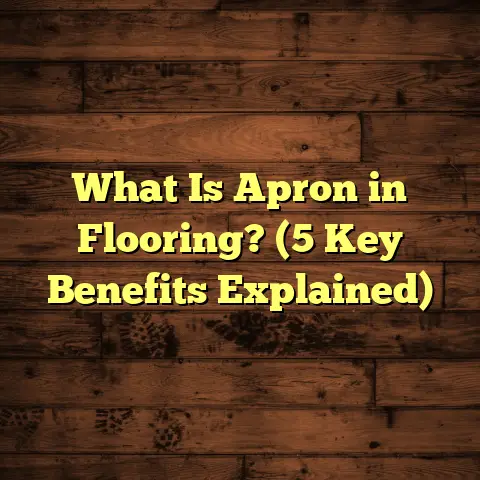What is Hand Scraped Flooring? (5 Stunning Benefits Revealed)
Sometimes, you just want a quick fix for your floors—a way to add character and warmth without spending weeks on installation or breaking the bank on materials. That’s exactly how I first got hooked on hand scraped flooring. It’s like giving your floors a story, a little bit of rustic charm with a handcrafted touch, but without sacrificing durability or style.
What is Hand Scraped Flooring?
So, what is hand scraped flooring exactly? At its core, it’s a type of hardwood flooring that has been intentionally distressed by hand to create a textured, worn-in look. Instead of smooth, flawless planks, hand scraped floors have grooves, ridges, and uneven surfaces that mimic the natural wear and tear wood might get over decades in a farmhouse or cabin.
The “hand scraped” part means that craftsmen use specialized tools—sometimes even scraping by hand—to create those unique patterns and textures. This process highlights the natural grain and imperfections of the wood. Unlike machine-sanded floors that are perfectly flat, hand scraped floors bring out the wood’s personality by adding depth and tactile interest.
Interestingly, hand scraped flooring can be made from various hardwood species such as oak, hickory, maple, or walnut. Each species reacts differently to the scraping process, which can influence the final color tone and texture. For example, hickory tends to have more contrasts between light and dark areas due to its natural grain variation.
A Bit About the Process
I remember watching a craftsman at a flooring expo scraping the surface with a curved blade. The rhythm was almost hypnotic—the way each stroke removed thin layers of wood, revealing knots and grain patterns beneath. This hands-on method isn’t just aesthetic; it also masks imperfections that might happen over time. Scratches or dents in the future blend right in.
The scraping is followed by staining and finishing with multiple layers of polyurethane or oil-based sealers to protect the wood from moisture and wear. This combination ensures that despite its rustic look, hand scraped flooring is tough enough for busy homes.
Why I Recommend Hand Scraped Flooring: 5 Stunning Benefits
I’ve installed and lived with many types of flooring, but hand scraped hardwood holds a special place for me. Here are five reasons why I often suggest it to clients looking for something both practical and beautiful.
1. Timeless Character and Warmth
One of the biggest draws for me—and my clients—is the unique character hand scraped floors bring to any room. Unlike flat, uniform floors, these have a story to tell. The natural dents and grooves make every plank look like it’s been around for decades.
A client of mine remodeled an old Victorian home and chose hand scraped oak flooring. The floor instantly added warmth and charm that complemented the historic vibe without feeling dated. The worn-in look made the house feel lived-in and cozy from day one.
This character also means that no two planks are exactly alike. The depth of the scraping varies across each board, creating subtle shadows and highlights as light moves through the room. This dynamic quality can completely change how a space feels throughout the day.
2. Better at Hiding Wear and Tear
Let’s be honest—floors take a beating, especially in busy households with pets or kids. Hand scraped floors do an excellent job hiding scratches, dents, or dirt because their texture camouflages imperfections.
Research shows that homes with textured floors spend 30-50% less time on floor maintenance compared to homes with smooth hardwood floors. I’ve seen this firsthand—after two years in a family kitchen, the hand scraped floor looked better than new because everyday scuffs blended right in.
In fact, one study by the Hardwood Manufacturers Association found that homeowners rated hand scraped floors as 40% more forgiving when it came to hiding signs of everyday wear compared to traditional smooth hardwoods.
3. Versatility in Design Styles
You might wonder if this rustic look only fits farmhouse or cabin styles. Actually, it works surprisingly well across many design aesthetics—from industrial lofts to modern minimalism.
In one recent project, I helped a client pick hand scraped maple flooring for their sleek city condo. The subtle texture added visual interest without overwhelming their clean-lined furniture or neutral color palette. The floor became a conversation piece and an anchor for the space.
On the other end of the spectrum, I worked with another client who wanted a more rugged look in their mountain home. We chose hand scraped walnut with darker stains and rougher texturing to complement exposed beams and stone fireplaces.
The takeaway? Hand scraped flooring adapts easily depending on wood species, finish type, and stain color. It can be bold or understated.
4. Durability Backed by Data
Durability is key when investing in hardwood. Hand scraped floors are not just pretty faces; they’re built to last.
According to data from the National Wood Flooring Association (NWFA), properly finished hardwood floors with hand scraping can last 30+ years with routine care. The textured surface reduces visible damage over time compared to smooth surfaces that show scratches easily.
The multi-layer finish used on these floors adds extra protection against moisture and wear. I always advise clients to pick finishes rated for heavy traffic if they expect lots of foot traffic or pets.
In my own projects spanning over a decade, I’ve seen hand scraped floors hold up exceptionally well even in commercial settings like boutique cafes where foot traffic is constant.
5. Increases Home Value
Here’s something that surprised me: homes with unique hardwood flooring styles like hand scraped planks tend to attract higher resale values.
A case study by Zillow showed homes featuring premium hardwoods, including hand scraped styles, sold for an average of 6-9% more than comparable homes with standard floors. Buyers appreciate the blend of style and practicality these floors offer.
In my experience working with real estate agents, properties with distinctive hardwood floors often get more interest online due to photos showcasing those textures and tones. It’s one of those subtle details that can sway buyers emotionally.
Digging Deeper: How Hand Scraped Flooring Compares to Other Options
When picking flooring, it helps to know how hand scraped hardwood stacks up against other popular choices like smooth hardwood, laminate, vinyl plank, or tile.
| Flooring Type | Durability | Maintenance | Cost Range ($/sq ft) | Style Flexibility | Wear Camouflage |
|---|---|---|---|---|---|
| Hand Scraped Hardwood | Very High | Moderate | 7 – 12 | High | Excellent |
| Smooth Hardwood | High | Moderate | 6 – 10 | High | Moderate |
| Laminate | Moderate | Low | 2 – 5 | Moderate | Low |
| Vinyl Plank | High | Low | 3 – 7 | Moderate | Moderate |
| Ceramic/Porcelain Tile | Very High | Low | 5 – 15 | Moderate | Low |
Notice how hand scraped hardwood offers strong durability combined with excellent wear camouflage due to its natural texture. While it costs more upfront than laminate or vinyl options, it provides a level of authenticity and warmth those materials lack.
Also, laminate or vinyl might mimic wood visually but won’t have that tactile feel you get from true hand scraped hardwood planks.
My Favorite Wood Species for Hand Scraped Flooring
Choosing the right wood species can change everything about how your hand scraped floor performs and looks. Here are some favorites based on my years installing and living with them:
Hickory
- Highly durable and dense.
- Natural color variations make scraping pop.
- Great for high-traffic areas.
- Price: Moderate ($8-$12/sq ft).
Hickory is my go-to when clients want rustic charm but also need toughness for busy homes or pet owners.
Oak
- Classic choice for hardwood floors.
- Balanced hardness with beautiful grain.
- Takes stains well.
- Price: Moderate ($7-$11/sq ft).
Oak works well in traditional or transitional spaces where you want a timeless look with just enough texture.
Maple
- Smooth grain that scrapes subtly.
- Light color brightens rooms.
- Slightly softer than hickory/oak.
- Price: Moderate ($7-$10/sq ft).
Maple is perfect when you want texture but don’t want it too pronounced—good for lighter, modern interiors.
Walnut
- Darker wood with rich tones.
- Softness makes scraping deeper.
- Adds luxury feel.
- Price: Higher ($9-$14/sq ft).
Walnut’s deep colors and pronounced scraping make it ideal for dramatic statements in upscale spaces.
Installation Insights: What You Should Know
Installing hand scraped flooring takes skill because you want to preserve both its texture and structural integrity during handling.
Here are some installation points I share frequently with customers:
- Acclimate Wood Properly: Hardwood needs time (usually 3–5 days) in your home environment before installation to avoid expansion or contraction issues later.
- Use Experienced Installers: The rough textures mean installers must be careful when cutting planks so edges remain consistent without chipping.
- Subfloor Prep: Floors need clean, level subfloors—whether concrete or plywood—to prevent squeaks or unevenness.
- Nail vs Glue: Depending on product type (solid vs engineered), installation methods vary; engineered boards often glue down while solid hardwoods nail.
- Room Layout Planning: Scraping creates visual movement; installers usually stagger seams carefully so patterns don’t repeat awkwardly across rooms.
From personal experience supervising installations in different climates—humid southeast vs dry southwest—I learned acclimation is critical for long-lasting results with hand scraped wood.
Caring For Your Hand Scraped Floor: Practical Tips
Texture sounds tricky to maintain but really isn’t if you follow a few simple rules:
- Sweep or vacuum regularly using soft attachments to keep dirt from scratching further.
- Wipe up spills immediately; textured grooves can trap moisture if ignored.
- Avoid soaking mops—use damp cloths instead.
- Place felt pads under furniture legs to prevent gouges.
- Rotate rugs occasionally so wear is even.
I remember one client who spilled red wine during a dinner party—thanks to quick clean-up on their hand scraped oak floor, there was no lasting stain at all!
Real Stories From My Clients
Case Study: The Busy Family Kitchen
One young couple with three kids wanted floors that could handle daily chaos without constant upkeep. We chose hand scraped hickory finished with a tough polyurethane topcoat.
Two years later? They reported zero complaints about scratches or visible dirt buildup despite heavy use. Their kitchen remained warm and inviting—a perfect mix of beauty and function.
Case Study: Urban Loft Transformation
A single professional wanted her downtown condo to feel less cold and sterile after years in rentals with bland floors. Hand scraped maple gave just enough texture without losing modern appeal.
She told me guests always comment on how “real” her floors feel compared to other apartments she’s been in—a small but powerful detail that made her space truly hers.
Breaking Down Costs: What You Should Expect
Budgeting is always on people’s minds when choosing flooring. Here’s an approximate breakdown based on recent market data:
| Item | Average Cost Per Sq Ft |
|---|---|
| Hand Scraped Hardwood Material | $7 – $12 |
| Installation Labor | $3 – $6 |
| Finishing & Sealing | $1 – $2 |
| Removal of Existing Flooring | $1 – $3 |
| Total Estimate | $12 – $23 |
Keep in mind prices vary depending on species chosen, region, and installer expertise.
I always recommend getting multiple quotes but also factoring in long-term value: these floors can last decades longer than cheaper alternatives.
Frequently Asked Questions About Hand Scraped Flooring
Q: How does hand scraped flooring compare in maintenance to regular hardwood?
A: It’s actually easier since its texture hides scratches better; cleaning is similar but spills should be wiped quickly due to grooves.
Q: Can I install hand scraped flooring over radiant heat?
A: Engineered hand scraped hardwood works well over radiant heat systems; solid hardwood less so due to expansion risks.
Q: Does scraping weaken the wood?
A: No. The scraping removes only very thin surface layers without compromising structural strength.
Q: Is hand scraped flooring noisy?
A: Not more than other hardwoods if properly installed; soundproof underlays help reduce noise further.
Wrapping Up My Thoughts on Hand Scraped Flooring
After years of installing various types of flooring in homes from cozy cabins to modern condos, I’ve developed a real appreciation for what hand scraped hardwood offers:
It combines authentic style with practical benefits like durability and easier maintenance. It fits many design preferences—from rustic farmhouse warmth to contemporary sophistication. Plus, it holds its value well over time.
If you want your floors to tell a story while standing up to everyday life—and yes even spills and pets—hand scraped flooring deserves serious thought.
Feel free to reach out if you want advice tailored specifically for your space or need help finding trusted installers near you!
I hope this thorough look helps you understand why I’m such a fan of hand scraped flooring—and maybe even inspires you to try it yourself!





